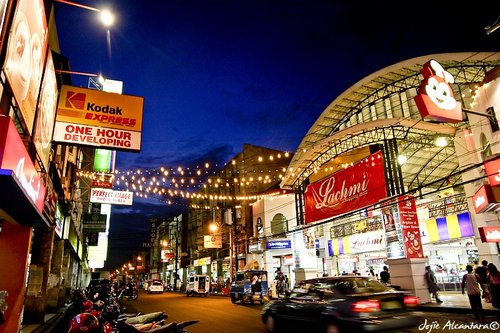[caption id="attachment_1174" align="aligncenter" width="405" caption="San Pedro at night (Photo by Joji Alcantara)"]
 [/caption]
[/caption](Below is my first ever published article in The Mindanao Times. I've been searching for the soft copy of this piece, and yesterday I finally found it. How things have changed! --- Arvin Ortiz.)
San Pedro Street offers a wide variety of amusements and attractions. You have the Rizal Park which occasionally stages cultural shows, musical concerts, and dance programs. In front of San Pedro Cathedral, you have Osmeña Park which is most visited by old folks not because it offers a refreshing place to relax, but because of the speech brawl and whimsical joust frequently conducted in the park, discussing diverse issues in politics, religion, and societal ills.
Meters away, you have a line of shopping malls—Unitop, Lachmi, Fabrica, etc.—with several items inside, offering latest products of high-end handbags, foot wears, and other such luxury goods as Dolce & Gabbana, Louis Vuitton with its famous “LV” monogram, Lacoste, Havaianas, Chanel, Gucci, Prada, Marithe Francois Girbaud, and the list keeps going.
Surprisingly, though, they are sold at hugely reduced prices, which made them suspect.
Any sophisticated consumer, of course, would have thought that luxury goods carrying those brand names but sold at San Pedro Street, could not claim any authenticity simply because those goods, if they were really authentic, have ridiculous price tags, which are always available only to the elite. Besides, those goods sold at San Pedro are easily recognizable as fakes. As one account put it, “they’re oftentimes made of compromised quality and standard: misspelled trademarks, shattered logos, distorted emblems…. Unpolished texture, poorly done stitches and second-rate materials are used in manufacturing these goods.”
Despite the enabling R.A. 8293 (Intellectual Property Code of the Philippines), which hoped to curb the proliferation of imitations that, according to its proponents, naturally harm the legitimate producers and the government that can not impose tariffs on imitations because they enter the country without the Bureau of Customs having to inspect them, imitation market remains vibrant.
On the other hand, commentators and legal scholars have recently criticized the orthodox justification that imitations harm the legitimate producers. Jointly working, legal scholars Kal Raustiala and Christopher Sprigman argued that piracy in Fashion Industry does not necessarily harm the purveyor of the original designer. In fact, it can be a necessary predicate. Their argument is compelling. But that’s another story.
Another commentator said, “incentive based justifications for intellectual property are subject to the factual preconditions that (1) there actually exist few or no effective extralegal means for preventing or delaying imitation, and (2) intellectual property rights are effective at thwarting imitators.” Barnett also argued that in some circumstances, imitations could enhance profits of the original purveyor of designs, which is obviously contrary to the assertion of incentive based thesis that imitations stifle investments in Fashion Industry.
Whether it’s the inutile IP law that explains why imitations are rampant, one thing is clear, “the biggest barrier to stopping, distribution and sale of counterfeit products remains insatiable demand as well as the widespread perception that, unlike pirated pharmaceuticals and foodstuffs, knock-off luxury brand goods are a victimless crime and therefore fair game.”
In a country where the poor compose the biggest number, no wonder these imitations persist. They serve needs. To be sure, they “satisfy the cravings of people for a taste of the good life.” And as cited by political economist Walden Bello, patrons of imitations “are basically harmless…And in a developing country like the Philippines, they are welcomed by the majority of cash-strapped consumers. The most important sign of their acceptability to society: their products sell, and sell better than the original. They are in fact considered as allies of the poor—an economic leveler—because they make things affordable to all.”
Which makes me think, can imitations really be stopped?

[...] Read some-more here: Imitation (San Pedro’s haute couture) [...]
ReplyDelete[...] More: Imitation (San Pedro’s haute couture) [...]
ReplyDelete[...] here: Imitation (San Pedro’s haute couture) Filed under: Uncategorized | Tags: Designer, friends, jane-links, lyrie, pedro-cathedral, piece, [...]
ReplyDelete